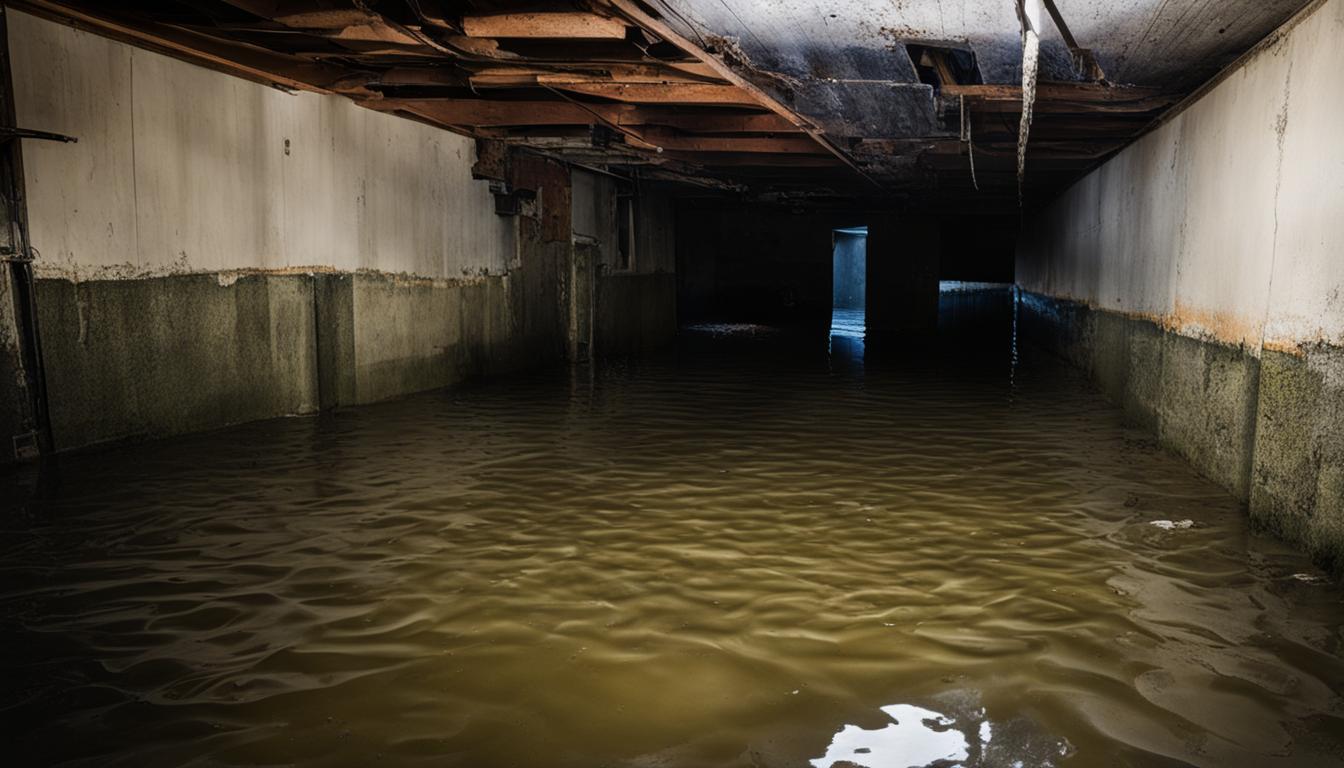Water damage is one of the most destructive problems a property owner can face. It can be caused by a wide range of factors, including floods, leaks, and inadequate plumbing. The most critical question is whether it is permanent or not. How do you know if water damage is permanent? It’s essential to be on the lookout for crucial signs that water damage may be irreversible.
Key Takeaways
- Water damage can be caused by various factors, including floods, leaks, and plumbing issues.
- Knowing the signs of irreversible water damage is crucial to take timely action.
- Early detection and quick action can prevent water damage from becoming permanent.
- Assessing the extent of water damage requires professional assistance.
- Preventing water damage is less expensive than repairing it.
Understanding the Types of Water Damage
Water damage can occur in several ways. You need to be aware of the different types to determine the best course of action for repair. Here’s a brief overview of the various types of water damage:
| Type of Water Damage | Description | Severity Level |
|---|---|---|
| Water Infiltration | A slow seepage of water through cracks or holes in the walls, ceilings, or floors. | Low to moderate |
| Leaking Pipes | Cracked, corroded, or damaged pipes that leak water and can lead to mold growth, structural damage, or burst pipes. | Low to high |
| Flooding | Water entering your home from natural disasters, storms, or sewer backups. It can cause significant damage to your home and its contents. | High |
Each type of water damage can lead to various long-term consequences. For instance, water infiltration can result in weakened structural integrity, while flooding can lead to mold growth, foundation damage, and increased risk of electrocution. It’s crucial to take action immediately to mitigate any damage from these types of water damage.
Now that you understand the types of water damage, you’ll need to know the initial signs of water damage to further detect and assess the extent of damage.
Initial Signs of Water Damage
Water damage can occur for many reasons, and it’s essential to act fast when signs arise. Some key initial signs of water damage include:
- Damp or musty odors: Unpleasant, stagnant odors can indicate that moisture is trapped, causing dampness on walls and floors. This smell might also come from old pipes.
- Discoloration or stains: Water discolors paint and leaves brown or yellow stains on ceilings and walls. It might also cause wood to warp, split, or show signs of rot.
- Mold or mildew: Any signs of mold or mildew signify high moisture levels and remain a potential threat to your health.
Remember, avoiding prompt action can lead to further damage and more significant expenses. Identifying the initial signs of water damage is the most critical phase to prevent further deterioration and protect the value of your property. When you are aware of any of these signs, don’t hesitate to call a professional.
Assessing the Extent of Water Damage
Assessing the extent of water damage is crucial to determining the appropriate measures needed to restore your property. The first step in assessing water damage involves looking for structural issues, such as cracks or buckling in walls or floors. Warped materials, such as bulging drywall, are indicative of water damage. Check for weakened foundations by searching for signs of foundation movement or shift.
It is crucial to keep in mind that water damage can be deceptive, as it can be present in areas that are not visible to the naked eye. This is why consulting with professionals is important in assessing the extent of water damage. Water damage remediation companies can conduct moisture readings and develop a comprehensive water damage assessment report that outlines the damages and necessary steps for restoration.
Further, water damage can have secondary effects on your property, including the growth of mold and deterioration of materials with prolonged exposure to moisture. Inspect for these issues as well when assessing the extent of water damage.
Signs of Irreversible Water Damage
If left untreated, water damage can lead to permanent and irreversible damage to your property. It’s important to be aware of the signs that indicate irreparable harm so that you can take appropriate action as soon as possible.
One of the most significant signs of irreversible water damage is the presence of black mold. This type of mold can grow quickly and spread throughout your property, leading to serious health problems for you and your family. If you notice black mold starting to grow, it’s essential to call in professionals immediately to begin the remediation process.
Another sign of irreparable damage is severely damaged structures. If walls, floors, or ceilings are starting to buckle or deteriorate, it may indicate that the water damage has become too severe to repair. In some cases, these structures may need to be removed and replaced entirely to prevent further damage.
Finally, compromised electrical systems are another sign that the water damage may be irreversible. Water can cause significant damage to wiring and electrical components, which can be challenging and dangerous to repair. Always consult a licensed electrician before attempting any repairs yourself.
Remember, when it comes to water damage, time is of the essence. The quicker you can identify the signs of irreparable damage, the better chance you have of preventing further harm to your property. If you suspect that your home or business has suffered water damage, don’t wait to take action. Call in the professionals and protect your property from irreversible harm.
Taking Action to Prevent Permanent Damage
If you suspect water damage, it’s crucial to act quickly to prevent the damage from becoming permanent. Here are some actions you can take:
- Seal leaks: Check your property regularly for leaks such as those from pipes, roofs, and windows. Repair them immediately to prevent water intrusion.
- Dry out affected areas: If you notice any dampness or moisture, dry out the area thoroughly. Use fans, dehumidifiers, and air conditioners to improve air circulation.
- Remove wet materials: Discard any materials that have absorbed water and cannot be salvaged, such as carpets, drywall, and insulation.
- Clean and disinfect: If water damage is due to flooding or a sewage backup, it’s important to clean and disinfect the affected areas to prevent the growth of mold and harmful bacteria.
- Seek professional assistance: For extensive water damage or when in doubt, seek the help of a professional water damage restoration company. They have the necessary equipment and expertise to handle the situation safely and effectively.
By taking these actions, you can prevent permanent water damage and protect your property from further harm. Don’t delay in addressing the issue, as the longer you wait, the more difficult and expensive it will be to repair.
Conclusion
Water damage can have serious, long-term consequences if not addressed promptly. By taking action early and seeking professional assistance, you can protect your property from permanent damage and avoid costly repairs.
Remember to stay vigilant for signs of water damage, such as musty odors or discoloration on walls and ceilings. Assess the extent of any damage by looking for structural issues and weakened foundations. If you notice signs of irreparable damage, such as the growth of black mold, seek professional help right away.
Prevention is key to protecting your property from water damage. Take steps such as sealing leaks, drying out affected areas, and regularly checking your plumbing and electrical systems. By being proactive, you can avoid the risk of permanent damage and ensure your property remains safe and secure.
Don’t wait until it’s too late – take action now to protect your property from the devastating effects of water damage.
FAQ
Is water damage permanent?
Water damage can be permanent if not addressed promptly. Ignoring water damage can lead to structural issues, electrical problems, and the growth of mold and mildew. It is crucial to take action as soon as you notice any signs of water damage.
What are the types of water damage?
There are various types of water damage, including water infiltration, leaking pipes, and flooding. Each type can have different levels of severity and long-term consequences. It is important to understand the cause of the water damage to address it effectively.
What are the initial signs of water damage?
Early indicators of water damage include damp or musty odors, discoloration or stains on walls or ceilings, and the presence of mold or mildew. These signs should not be ignored, as they can indicate underlying water damage that needs immediate attention.
How can I assess the extent of water damage?
Assessing the severity of water damage requires looking for structural issues, warped materials, and weakened foundations. It is advisable to consult professionals who have expertise in evaluating water damage to get a thorough assessment.
What are the signs of irreversible water damage?
Signs that water damage may be permanent and irreversible include severely damaged structures, compromised electrical systems, and the growth of black mold. These signs indicate significant damage that needs immediate action to prevent further harm.
What actions can I take to prevent permanent water damage?
To prevent water damage from becoming permanent, it is essential to seal any leaks, dry out affected areas, and seek professional assistance. Acting promptly and addressing the issue can help mitigate further damage and protect your property.









